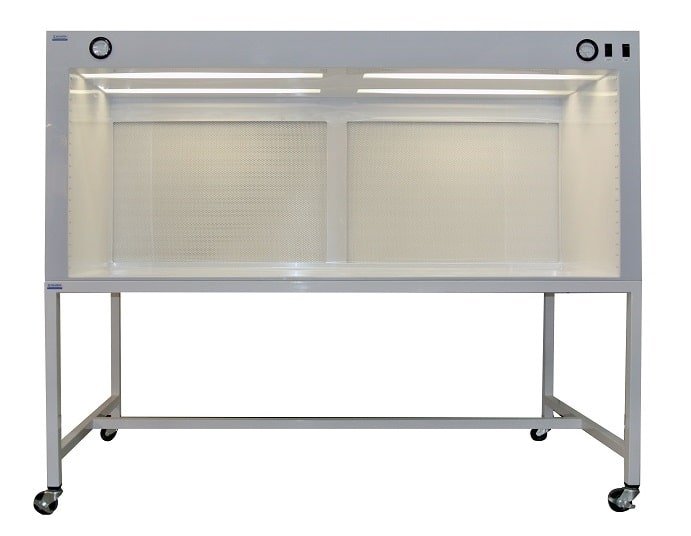Since air blows directly to the maker, the samples are less polluted by hands and gloves. Applications with ISO 5 requirements such as IV preparation, non-biological cultivation of tissues, electronic assembly, non-hazardous drug compounds, parts inspections, or optic assembly are ideal. Horizontal laminar flow hood has a filtered airflow that protects the sample from airborne contamination around the work area.
Horizontal laminar flow hood is suitable for a range of uses, particularly for clean air and sterile environments such as many medical and research laboratories, sterile equipment assembly workplaces, or electronic devices are required. The sterile air is flowing from the top of the container to the working surface in a vertical hood.
The user in Horizontal laminar flow cabinets is clean air from a tank located behind the work surface. The horizontal laminar flow hood may be used in horizontal or vertical airflow configurations. A horizontal flow cap passes air through HEPA or ULPA filters from back to the front of the work surface.
Recommended reading: Discover 5 amazing uses of Wall Wraps – Ultimate Tips
Fans and filters sit atop a vertical configuration hood. Particles that are not collected by filters are forced out via the unit’s front access area. A vertical flow tends to transfer micro-contaminates onto the work surface or laboratory floor, preventing pollutants inside the structure from floating around. Laboratories with limited floor space may want to go in a vertical setup.
The fan and filters at the top of the unit allow a standard laboratory bench to install the flow cap. In comparison to a vertical flux hood, additional rear clearance is required for a horizontal flux configuration to allow air to reach the package. A deeper working base and floor space are required due to the positioning of the fan and filter. A vertical flow hood can be needed when dealing with smaller particulate applications such as the pharmaceutical industry.
All vertical installations have a sash shield to prevent the user from inhaling pollutants. A horizontal flow hood allows for greater overhead clearance and a deeper workspace. The hands and gloves of an operator will be less contaminated, as air is pushed from the top of the unit.
Recommended reading: Decluttering Tips For Downsizing
5 Techniques for the effective use of the laminar horizontal flow hood
- Horizontal laminar flow cabinets are used when a clean environment is required that is free of particles or biological contaminants. Famous examples are tissue cultures or semiconductor wafers. Horizontal laminar flow cabinets avoid airborne pollution coming into the workspace of the cabinet. The laminar airflow ensures that samples are reduced by cross-contamination.
- Air filtered by HEPA filter and expanded to the user via the workplace. A steady flow of clean air externally holds an uncontaminated workspace. Some laminar cabinets have a UV-C lamp, which disinfects the workspace before use. Always be careful not to place items downstream of items, which could result in cross-contamination. This is especially important where biological samples are used.
- Horizontal flow cabinets blow clean air horizontally from the back of the cabinet to the user, while vertical flow hood blows fresh air from the cabinet ceiling to the workspace floor where it then reaches the base and flows horizontally toward the user. There is no sash to the horizontal flow cabinets.
- The more items inside the cabinet, the greater the likelihood of contamination. Large items can cause flow disruption. Ensure the hand/glove and all items carried into the cabinet are contaminated free before entering the cabinet. All products have to be positioned 6 inches or further from the opening edge of the cabinet. The air is more likely to interact with the outside air within 6 inches of the ground, meaning items within 6 inches are more likely to be polluted.
- In order to ensure that it works securely, routine maintenance on a laminar flow cabinet should be carried out. In-cabinet leakage controls and airflow rate tests should include control and replacement of the HEPA filter. HEPA filter integrity should be checked by testing the number of particles that pass through the filter. If the rate of flow is too low, the cabinet will be inefficient to prevent contaminants.
Recommended reading: 7 Tips For Moving Interstate
Conclusion of Horizontal laminar flow hood
Now it is clear that there are 5techniques for the effective use of the Horizontal Laminar Flow Food that can be quite beneficial for the users. The one who is willing to take advantage of the same to purify the air or keep the working environment clean can contact us
Further, the interested candidate who desires to gain more information about the Laminar Horizontal Flow Food feel-free to get in touch with us.
If there is any query about the highly-rated services don’t hesitate to contact us.
This post was created with our nice and easy submission form. Create your post!




